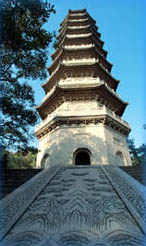 The temple used to be a large one and covered covering an area of over 500 mu but was unfortunately damaged during the war in the reign of Xianfeng in the Qing Dynasty. The present temple is one part of the original temple and is the only temple that survived among more than 70 temples built in the Southern Dynasty in Mountain Zhong.
The temple used to be a large one and covered covering an area of over 500 mu but was unfortunately damaged during the war in the reign of Xianfeng in the Qing Dynasty. The present temple is one part of the original temple and is the only temple that survived among more than 70 temples built in the Southern Dynasty in Mountain Zhong.
Wuliang Hall lies within the Linggu Temple. It was constructed in 1831, and is 22 meters high and 53.8 meters wide. Since the Buddha of Infinite Life was offered here to be worshiped, the temple was named Wuliang meaning "infinite". The hall enjoyed great popularity due to its special architectural techniques. It is the biggest largest and oldest no-trussing hall in China. It was built by piling up bricks without a single pillar or beam from the bottom to the top. Since "no-trussing hall" has the same pronunciation in Chinese with the "infinite hall", the hall can also be called Wuliang hall meaning "no-trussing hall". In November 1928, the government of Nationalist Party decided to replace the Linggu Temple with the cemetery for sacrificed soldiers. More than 33,000 soldiers' names were carved on the hall.
Three-superb Tablet: There is a painting of Monk Baozhi, painted by Wu Daozi, a famous painter in the Tang Dynasty, a poem written by Libai, an outstanding poet in the Tang Dynasty, and calligraphy written by Yan Zhenqing, a well-known calligrapher. For As the painting, poem and calligraphy are all rated as superb works of art, the tablet was honored as "Three-superb Tablet". The present Tablet is a duplicate by Monk Fa Shou in the Qing Dynasty during the reign of Emperor Qian Long.
Linggu Pagoda: It is in the back of the Linggu Temple, built in 1929, and originally named as memorial pagoda for sacrificed soldiers in the national revolution. It was reinforced with concrete, it stands over 60 meters high. A spiral staircase will lead you to the top story of the pagoda.
How to Get There: One can take tour bus 2, 3 and get off at Linggu-Si bus station.
Ticket: 10 yuan (US$1.2)
Open Time: 7:00-18:30
(china.org.cn February 21, 2003)
|

